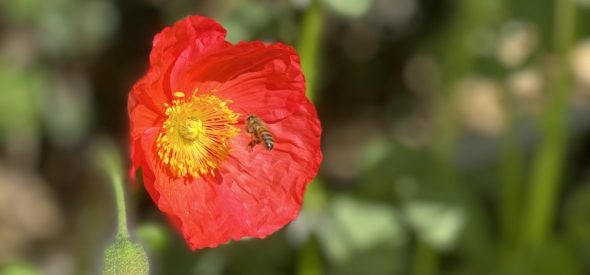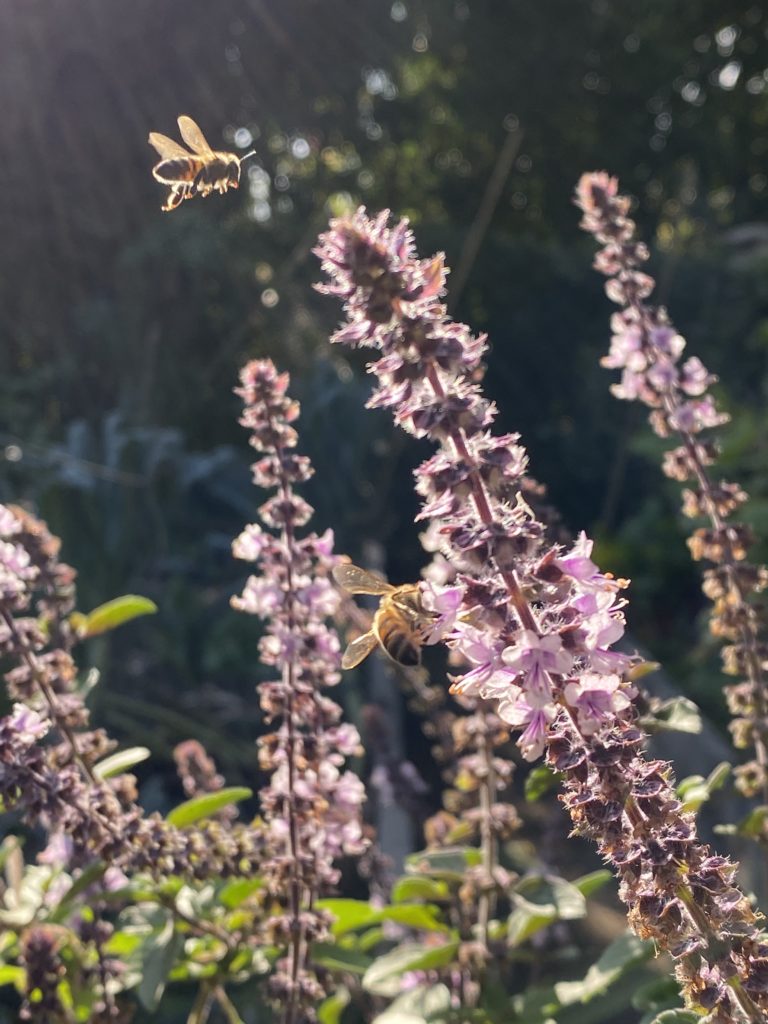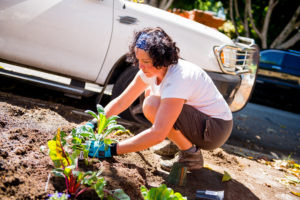Pollinator Gardening…bees, butterflies and hummingbirds.
0March 1, 2020 by Hope Gardens


I’ve worked in edible gardening and native landscaping for over 13 years. Permaculture and sustainability are the backbones of my business. My mission, both in my business and at my own home garden, is to support natural – as in the earth’s own – practices. I created my own “best practices” to acknowledge that our gardens are part of a larger ecosystem. They include:
- Make friends with bees and earthworms and seasonality and leaf litter.
- Use water wisely.
- Respect my locality – my climate, the micro-ecosystem of my yard.
- Compost
- Share knowledge. And tomatoes.
- I use “best practices” in my garden and life to avoid future need for intervention. Interventions and remedies are usually what ends up being harmful to our environment. Including our pollinators and ultimately, us.
We need our garden to be part of the ecosystem and that’s made very evident when you look at how bees and other pollinators support our food systems.
How many times does it take for a bee to pollinate a squash blossom (which has male and female flowers)? Minimum 7 hits. A bee or other pollinator needs to travel back and forth from male to female flower at least 7 times for the female to be fertilized and capable of growing a squash. So it’s very important to attract and keep those bees in your garden. Let me share my approach to gardening.
- ORGANIC – this means life! Bring life to your garden. Be present. Keep you soil alive. Enjoy your garden. From there you need to define organic for yourself. Generally organic refers to natural, as in non-chemical and not man-made, non-synthetic. For me and my business, organic means you can eat out of my garden without washing the produce. For the Topanga Nursery and Valley Hive it means no spraying of pesticides or fungicides ever. What’s important is how you define organic for yourself.
- CONTAINER GARDENING – I do a lot of container gardening. Vital compost, amendments, fertilizers get lost in the ground through erosion. Native soil (the soil under our feet) gets compacted when we walk on it regularly. This doesn’t happen when you plant in containers. Containers have come a long way! Talk to me about amazing grow bags. Inexpensive, portable, unbreakable and best for roots and plant development.
- SOIL – there is life in your soil or there should be. An alive soil has microbes and micro-nutrients. The best way to add this to your soil is through compost and leaf mold and worms. You can also add teas, liquid and dry fertilizers and amendments. Our vegetable garden workshops will deep dive into this. Make sure you use new potting soil in containers – no matter how big the container. When you amend existing native soil use planting mix. Containers: potting soil. In-ground: planting mix.
- Depending on what plant you are planting you need to be aware of the pH. Most plants want a balanced pH or somewhat alkaline. Our native soil is alkaline which is why SoCal is such a great agricultural mecca. To ensure good pH most gardeners add dolomite lime to new plantings especially tomato and other vegetable gardens. In contrast, blueberries like a very acidic soil. I keep them in independent containers for that reason. Azaleas and other plants like acid too and you will find fertilizers and soils dedicated to them. A balanced pH is 6.5 and a pH meter is a good investment.
You may be saying: what the honey does this have to do with pollinators? Well friend, these are your “best practices.” This is all part of an extremely important part of your garden/eco-system building journey: it’s about the foundation for a healthy thoughtful garden. You want to get a good start – the best possible start – to eliminate the need for harmful future remedies that endanger bees and other pollinators.
Most flowering plants – your pollinators’ bread and butter – want the same thing: sun (6 hrs), regular water (let the top inch or two of the soil dry out), good soil, some fertilizing, mulching – protects roots and our soil. Once or twice a year give a dose of general organic natural fertilizer, some worm castings and some extra soil and mulch. And most plants want trimmed back in the fall. These are the norms you need to follow religiously.
Speaking of fall: our seasons seem non-existent but they’re not. I get very defensive when people say we don’t have seasons. We have lots of seasons. Award season. Fire season. But srsly it’s very important to be tuned into the seasons. The real seasons. Our fall doesn’t start when Starbucks comes out with their pumpkin latte. It starts after Halloween when the days get cooler. So be tuned into your micro-season the way you are tuned into your micro-ecosystem.
Let’s talk about fertilizers. Chemical fertilizers and organic fertilizers work very differently. Chemical fertilizers are strangers to your plants. Natural fertilizers they know what to do with. This is the difference between 30-30-30 vs. 3-3-3. The numbers on a fertilizer bag refer to N-P-K.
N is Nitrogen and that’s responsible for growing stems and branches and leaves. Phosphorous is P and grows roots, fruits and flowers. K is Potassium and it also grows fruits and flowers. P and K are usually found sourced together. N can be singled out and is the easiest to add to plants. Plants can get N from potting soils and compost and worm castings and green manure. (Addendum: Soil tests have concluded that bagged potting soils are very low in N. Not sure why, but I’ve had to add much more N than usual. Animal-free sources are soybean meal and neem seed meal.)
Since we are talking about bees and flowers today, we want to focus on fertilizers that give us blooms. To encourage flowers and fruits, we need to add fertilizers higher in phosphorus and do that both when you turn over your beds and when the plants are setting blooms. An animal-free source of phosphorous is rock phosphate. Rock phosphate also contains calcium. Not all rock dusts are the same so check the label.
Liquid fertilizers like seaweed/kelp or compost tea or other botanical tea are also great. They can be added as a root drench or foliar feeding monthly in containers. Concentrate 2T per gallon. Seaweed can be high in potassium so don’t over-use.
Let’s talk about plant choices.
BEES
So we talk about plants that are “bee magnets.” As you probably know that’s NOT how bees are drawn to plants. A plant may have a certain “magnetism” but it’s not a literal magnet.

So what does make a plant irresistible to a bee? A certain kind of flower is ideal.
- They like a flower with a center and a single rim of petals best: the daisy for example.
- Also a plant with lots of small flowers that bees can spend a long time at are their favorite.
- Flowering herbs are the perfect example of this: basil, rosemary, mint, chives, sage, lavender, borage, thyme, oregano. And there are many sub-varieties of these plants so feel free to collect several. Lemon basil, african blue basil. Chocolate mint, pineapple sage, lemon thyme.
Herbs are excellent additions to pots and also make great groundcovers. They tolerate shade but need sun to flower (and attract bees) and they need regular watering.
Native plants are used to this soil, this weather and so grow easily to plants we are trying to force into a situation. These are your hometown heroes.
Yarrow
Poppies
Salvia
Penstemon
Mallow
Manzanita
Ceanothus
Barberry
Milkweed – native only. Tropical milkweed has been found to be harmful to monarchs.
Dudleya
Redbud
Yucca
Heliobore
Verbena
Non-CA native plants that are drought-tolerant and bee-attractors include some perennial favorites like:
Scabiosa
Echeveria
Lavender
Sweet Alyssum
Kangaroo Paw
Lantana
Westringia
Breath of Heaven
Euryops
Aster
Beyond herbs, there are many edible and medicinal FLOWERING PLANTS that attract bees as well. These are my most-loved plants: MULTI-MULTI PURPOSE PLANTS
Calendula E
Wild Bee Balm/Bergamot E
Marigolds E
Nasturtium E
Yarrow E
Sunflower E
Lavender E
Citrus and other fruiting trees E
There are a couple extra things you need to add to your yard to provide a HEALTHY BEE ENVIRONMENT!
- water to drink – bee baths are an extremely complicated combination of twigs, rocks, a shallow saucer or bowl and some daily water. That’s sarcasm. It’s JUST some shallow water with natural insect perches. You got this.
- shelter – leave some leaf litter – if possible limit your mow and blowing, live with some leaf and flower “mess” or better yet embrace it! The benefits of a leaf pile are beyond just sheltering a hostel of bees. There’s gold in them piles! Leaf mold is a form of fungal compost that comes from the difficult process of letting a pile of leaves rot in your yard. You can add this as brown materials to your compost or use it straight up as its own compost. And you are sheltering bees. Win Win Win!
Now let’s talk about dangers: those remedies we are trying to avoid.
It’s very important to DECREASE THE RISKS OF CHEMICAL CONTAMINANTS coming into contact with bees.
You can learn to live with some pests. They say if nothing’s eating your plants you’re not part of the eco-system.
And we are building an eco-system so we are definitely a part of it.
Let’s talk about organic ‘cides.
- most organic pesticides are biological controls, not a poison per se. They are formulated to harm one specific kind of bug.
- BUT all are growth inhibitors and can harm bees and your plant over time.
- to limit your use of pesticides or fungicides – do things right the first time…take the long way home. If you set yourself up for success with the “best practices” we talked about and if you visit your garden often, you can avoid using harmful remedies.
There are some other ways to prevent insects and disease as well.
Interplant! Add herbs to your vegetable garden and mix up the plantings of your vegetables. I don’t put one broccoli after another in a long line – I mix it up so pests and disease can’t just hop plant to plant.
Now this is different than how you can plant your bee-attracting shrubs. It’s advised to plant your pollinator-attracting shrubs in groups as our bee friends go after one VARIETY of plant at a time and if you can have them all in a group all the better. Our bee-attracting shrubs don’t have many problems with disease or pests so planting them together isn’t an issue.
However it’s always important to plant the right plant at the right time. Now at heart I’m a rebel my garden warriors but go with the flow. Follow the rules. Don’t plant plants not meant for our climate. If a plant doesn’t do well in your yard, don’t fight nature. Plant something else. Follow your eco-system’s lead.
Plant disease-resistant plants.
- Visit your garden often. The best fertilizer (and pesticide and fungicide) is the shadow of the gardener. Show up. Look. Explore. Enjoy. Utilize. Notice.
- This quote is older than our dirt and it’s never been more relevant. And as goes veggies and bees and spouses and children and therapy….the more you put in, the more you get out.
- Insects can be hand-removed or sprayed with a hose. Infected leaves by disease or pests or even entire plants should be removed and thrown away.
So let’s say you’re still going to spray.
Spray something organic. At home soap sprays can be very toxic. Don’t spray Dawn dishwashing liquid on your plants. Certainly don’t spray an anti-bacterial spray on your plants. A castille soap like Dr. Bronner’s is perfect. Peppermint or unscented. 1 Tbsp to a quart of water. Spray plants twice daily, in the cool of the day, until infestation clears.
Other commercial insecticidal soaps, neem oils, etc are applied as a foliar application (sprayed on plant leaves) and are effective on a wide range of plant pests when the soap spray comes into contact with the pest. Most commercially available insecticidal soaps are made of potassium salts of fatty acids and kill by disrupting the structure and permeability of insect cell membranes. Use in early morning or at night when bees are less active.
If a plant is flowering or about to flower don’t spray it. If you can actually remove the flowers by pruning from around the treated plant, and anywhere your application may drift, you can significantly reduce risk to bees and other pollinators.
BUTTERFLIES

Pictured above is a non-native milkweed called Tropical Milkweed. There’s alot of information coming out about native vs. non-native milkweed and the cons of capturing butterflies and caterpillars. Please do not move butterflies or caterpillars away from their habitat. More info on the latest science on protecting pollinators here.
Butterflies use milkweed as host plants meaning they lay their eggs on these specific plants and when the eggs hatch, the baby caterpillar consumes that same plant. Therefore, this plant is very important to support monarchs. Please do your research.
Adult butterflies also need nectar plants to feed on. Here’s a list.
Nectar flowers for butterflies
Cosmos
French Marigold E
Euryops
Candytuft
Lavender E
Asters
Gazania
Lantana
Salvia
Sunflower E
Seaside Daisy
Verbena
Bee Balm
Butterfly Bush
Flowering Sedum
Mallow
Scabiosa
Coreopsis
Yarrow
Zinnia
And…Ceanothus gets the award for hosting most native butterflies!
Some more tips for your butter’ ecosytsem:
- Butterflies, like bees, need some muddy water to drink. They also like large rocks and other perches/shelter (trees, shrubs, lawn furniture) for warming their wings.
- Don’t overprune your plants – you may cut off an egg or chrysalis.
- Avoid Bt. It kills all caterpillars. Hand pick off “bad caterpillars” like cabbage worms and hornworm caterpillars.
- Butterflies will change their habits to accommodate a good food source and their babies can return year after year!
HUMMINGBIRDS
Birds like a mix of tall trees, shrubs, and patches of meadow and lawn. Once hummingbirds discover your property, the same individuals are likely to return each year at about the same time; they are remarkable creatures of habit. The number of hummingbirds that frequent your yard is closely linked to the abundance of food, water, nesting sites, and perches.
Choose red, tubular flowers, as these are quick clues to a flower’s value as a hummingbird food supply. Hummingbirds are also attracted to orange and pink flowers.
Female hummingbirds usually line their nest with soft plant fibers.

- Only mom builds the nest and visits it. One favorite is the fern* which has a fuzzy stem. Leave some thistle and dandelion and other favorite nest-building materials in your yard. Don’t remove any spider webs that appear among the plants. Yay!!!
- Hummingbirds use the delicate threads of these webs for material to build nests. And hummingbirds often steal insects that are trapped in spider webs.
- Don’t spend too much time near hummingbird nests as the birds are skittish and can be scared away from a nest and abandon their eggs.
- Avoid insecticides. Hummingbirds can ingest poisons when they eat insects; systemic herbicides can also be found in flower nectar.
- Provide water baths. Like most birds, hummingbirds frequently bathe in shallow water—even in the drops that collect on leaves. Hummingbirds may sit and fluff through the droplets generated by garden misters, drip fountain devices, and also small waterfalls. Water fountains are wonderful for all forms of wildlife.
Plants for Hummingbirds
Canna lily
Aloe
Hyssop
Alstroemeria
Bee balm
Begonia
Bird of paradise
Bottlebrush bush
Butterfly bush
Cardinal Flower
Cosmos
Delphinium
Desert willow
Fruit Trees
Fuchsia
Hibiscus
Honeysuckle vine
Impatiens
Indian hawthorn
Mock Orange
Indian paintbrush
Jacaranda
Joe pye weed
Lantana
Lavender
Lily of the nile
Mandevilla
Nasturtium
Mexican Bird of Paradise
Passionflower Vine
Penstemon
Pentas
Petunia
Red hot poker
Rose of sharon
Salvia
Shrimp plant
Snapdragon
Trumpet Creeper vine
Yarrow
Zinnia
Scarlet runner bean
Cleveland sage
Pineapple sage also called Hummingbird sage
Okra
Day Lily
Tall grass (Muhly) for hiding and nest making
Thank you for your passion and interest in pollinator -gardening. Enjoy your garden and your eco-system! And visit us again soon.

Category Landscaping | Tags: bees, butterfly, hummingbird, pollinator, Vegetable Garden, vegetable gardening


